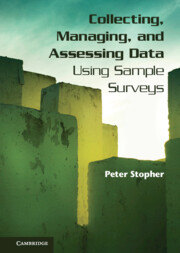Designing Effective Web Surveys
Designing Effective Web Surveys is a practical guide to designing Web surveys, based on empirical evidence and grounded in scientific research and theory. It is designed to guide survey practitioners in the art and science of developing and deploying successful Web surveys. It is not intended as a “cook book”; rather it is meant to get the reader to think about why we need to pay attention to design. It is intended for academic, government, and market researchers who design and conduct Web surveys.
- Guides the reader through developing and designing effective web surveys
- Based on solid research and empirical evidence
- Uses examples to highlight the elements of good and bad survey design
Reviews & endorsements
"This is the right book at the right time. Increasing concerns about the quality of the data being collected online are pushing researchers to focus more on design, and to create more engaging and more usable online questionnaires. In an area where there is no shortage of opinion about what works and what doesn't work, Mick Couper gives us practical advice based in science and data. His grasp of the subject matter and his command of the relevant methodological literature has produced a book that stands alone."
Reg Baker, Market Strategies International
"What a treat! No one has been more passionate about the design of web questionnaires than Mick Couper, and this book is a tour de force - a broad, deep, thorough, and insightful array of data-based advice on optimizing web surveys. Many of the most important surveys in the future will be done via the Internet, and Mick's guidance about how to collect the most accurate data possible will no doubt guide the next generation of researchers carrying out this work."
Jon A. Krosnick, Frederic O. Glover Professor in Humanities and Social Sciences, Stanford University
"Mick Couper was present at the creation of the brave new world of web surveys and no one knows the field better. His new book is an invaluable compendium of careful research and practical wisdom gained from over a decade of experience. Couper shows how design decisions affect both the respondent experience and the quality of data collected. Unfortunately, there are lots of bad web surveys. Anybody who wants to conduct a good one should read this book."
Douglas Rivers, Professor of Political Science, Stanford University and co-founder of Knowledge Networks and Polimetrix
"Mick Couper has written the book that web survey researchers have been waiting for. Designing Effective Web Surveys is a well-written, comprehensive overview of web survey procedures. Using a minimum of technical jargon, Mick provides the information needed to conduct high-quality web surveys. Every researcher involved in web surveys should read it."
John Kennedy, Center for Survey Research, Indiana University
"This book provides a comprehensive and practical guide to designing web surveys which is long overdue. Couper's recommendations are grounded in theory and supported by empirical evidence. His use of full-color examples culled from a wide variety of genres effectively illustrates his recommendations and serves to underscore his point that while the web is a powerful tool for survey researchers, the design of a web survey must be approached with care. His book is certain to be an extremely useful addition to both the teaching and practice of survey research."
Rachel A. Caspar, RTI International
"This work represents the most comprehensive treatment of the subject this reviewer has encountered. Couper … provides a wealth of insights into the design of Web surveys, demonstrating many of the potential pitfalls of various techniques from the respondent's point of view … This useful resource will influence the way web surveys are developed for some time … Highly recommended."
Choice
"Designing Effective Web Surveys is a must-have addition to the library of anyone who routinely conducts web-based surveys. Couper’s book is a very thorough treatment of key aspects of designing and implementing web surveys, with the overriding purpose of assisting researchers in designing web surveys that produce high-quality data capable of producing valid estimates rather than producing data quickly and economically … Couper’s book is an important and much needed addition to the existing survey research literature on web surveys. The book is almost worth the cost just for the voluminous bibliography of previous research on web surveys."
James J. Bason, Survey Research Center, University of Georgia, Journal of Official Statistics
Product details
September 2008Paperback
9780521717946
416 pages
235 × 177 × 22 mm
0.92kg
207 colour illus. 1 table
Available
Table of Contents
- 1. The importance of design for web surveys
- 2. The basic building blocks
- 3. Going beyond the basics: visual and interactive enhancements to web survey instruments
- 4. General layout and design
- 5. Putting the questions together to make an instrument
- 6. Implementing the design.






